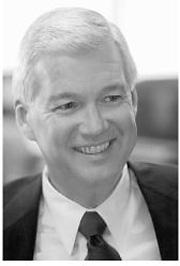DESPITE THE VOLATILE state of the print journalism world, all appears calm beneath the spinning P-I globe.
Since the new publisher of the Seattle Post-Intelligencer, Roger Oglesby, took over in early March, the daily newspaper industry has absorbed a pair of major shocks. The Los Angeles-based Times-Mirror company, publishers of the Los Angeles Times and Oglesby’s former employer, has been purchased by The Chicago Tribune. In Denver, the two competing morning newspapers, the Denver Post and the Rocky Mountain News, were seen as a model for Seattle’s coming battle, but stunned observers by announcing their intention to enter into a joint operating agreement.
Both events are potentially good indicators for success in Seattle. Our own JOA, which handed business operations at the P-I over to the rival Seattle Times in 1983, was considered one of a dying breed until the Denver papers took the leap. The Times-Mirror purchase also represents a huge “old media” investment in an industry for which many had predicted an Internet-dominated future.
Oglesby argues that newspaper companies have no reason to fear the future. Local news is the staple of any successful daily paper and “newspapers have the best local content in the country,” he says. “The newspaper industry has been saying for a number of years that we in the newspaper business are in the content business.”
The several-page redesign that debuted Monday, May 22, could be called the P-I‘s first shot in the newspaper war. Changes include nods both to tradition (the newspaper’s trademark globe has been added to the front page nameplate) and to industry trends (TV listings have been expanded and a USA Today-style full-page color weather report added).
Of course, an even more surprising development to local readers came shortly after the Times moved from afternoon publication to give Seattle two morning newspapers—the P-I began blowing its own horn. The newspaper expanded its previous promotional focus of touting Pulitzer Prize-winning cartoonist David Horsey with advertisements spotlighting numerous members of the P-I staff. Oglesby loves the campaign.
“Promotion is important to a newspaper and it’s important for the P-I to have a promotional presence in the market right now,” he says. “[We want] to let people know we’re still here and strong and shouldn’t be forgotten in the rush of curiosity” over the Times‘ switch to morning publication.
OGLESBY’S HIRING HAS proven popular in the newsroom. Oglesby is a relatively young (51) newspaper executive who left a high-profile job (president of the LA Times’ Orange County edition) to take the reins of the P-I; observers see his appointment as a sign that the Hearst Corporation is dedicated to keeping its Seattle paper up and running. Last year, when the parties amended the JOA to allow the Times to publish in the mornings, some initially suspected that the concessions granted Hearst could make folding the P-I a financially attractive option.
Also, as the P-I employs only journalists (advertising, circulation, and production functions are performed by the Times), the new publisher’s credentials as a former reporter and editor naturally endeared him to his new employees. Oglesby attended law school while working as a copy editor for the San Francisco Examiner, and his r鳵m頩ncludes a stint in private law practice and four years as a corporate attorney for Times-Mirror.
In person, the new P-I boss comes off as a pleasant and remarkably politic man. Oglesby sang the praises of competition, saying Seattle newspaper readers will benefit as the Times and P-I compete head-to-head in the morning market. “I think you’ll see two very good newspapers get better and sharper,” he says.
He likens the Seattle market to his former situation in Orange County, where the LA Times’ Orange County edition battled the more established Orange County Register. Competition simply makes for better newspapers, he says. “You will see some of the best local journalism being produced anywhere in the country in Orange County.”
It’s still a little early to gauge the effects of the Times‘ switch to morning publication. Recently released circulation figures showed single-digit declines for both papers, but the six-month survey included only the first month of dual morning operations.
While he promises continued improvement at the P-I, Oglesby was quick to clarify a comment printed in his own paper after he accepted the job here. In it, he said the best way for the P-I to increase its circulation is to be “a compelling newspaper.” He wasn’t speaking in future tense, he notes. “I think this is a compelling newspaper.”






